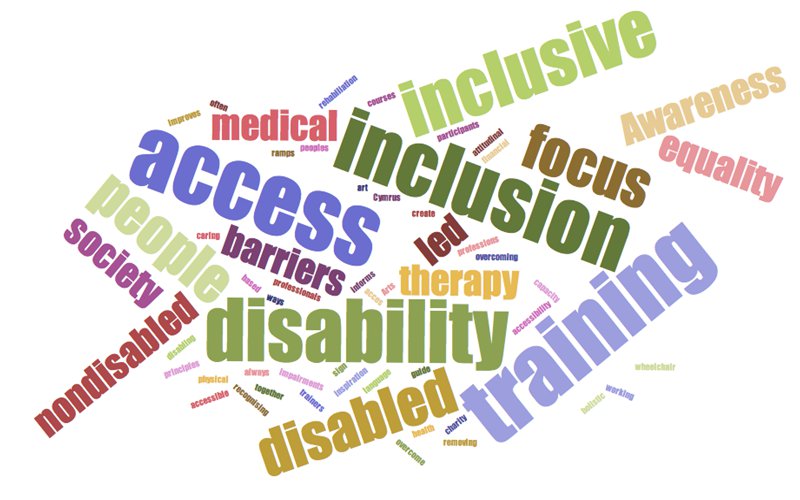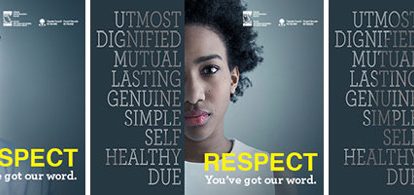October 17, 2016 – Michele Decottignies, for The Deaf, Disability & Mad Arts Alliance of Canada and panelist at CAPACOA @ CINARS asks the question:, “Why is “art” missing from a search of “disability art” in the largest database in the world?”
Take the time to do an internet search of “disability arts”, on any given day. Here is a summary of what you’ll typically get the most hits on:

Notice how the most important thing of all is barely discernable?
Where is the art?
Why is “art” missing from a search of “disability art” in the largest database in the world?
Why is our art so hard to spot in the professional arts ecology, even after a 45 year-long history of vibrant and varied disability arts production in Canada – by a volume of highly accomplished artists such as Jeff Healy, Jane Cameron, Leah Lakshmi Piepzna-Samarasinha, Laurence Brunelle-Côté, Tiphaine Girrault-Bath, Lyle Victor Albert, Onyii Udegbe and so many more!
Why? Because people with disabilities tend to be unconsciously misunderstood as a class of people who are both “less capable” and “less beautiful”. That is… less capable and less beautiful than “normal” people.
Of course you aren’t going to find our collective body of disability art work. Not within a professional arts ecology that idolizes Eurocentric notions of what is and is not “aesthetically pleasing” in popular culture.
So let me assure you here and now: There is currently no greater “ghetto” for artists with disabilities than a mass/ popular culture that relentlessly devalues us. Without even knowing it.
In popular culture, the representation of people with disabilities is limited to three choices [1]:
- Victims: We’re treated as objects of tragic afflictions that burden us and society. But this choice turns us into objects of pity and sympathy. [2]
- Heroes: The flip side to the victim trope is the hero. These characters have to prove their worth by overcoming their disabilities. But this choice turns us into what we call Inspirational SuperCripsTM! [3]
- Villains: A third common stereotype is the villain. Throughout history impairments have been used to suggest evil or depravity. But this choice turns us into a class of violent people that rest of society needs to be protected from. [4]
Some choices, eh?
Although we’ve come a long way in the past 50 years, since the days of the Jerry Lewis Telethons for us “pitiable half-humans”, opportunities for artists with disabilities to contribute to the Canadian cultural canon have recently also been limited to only three choices:
- The art of objectification, wherein “disability” itself is again being treated as an object of wonderment and fascination.
- The art of benevolence, wherein the disabled are included in the arts in order to help us get better. But we aren’t broken people and don’t need fixing. [5]
- The art of self-determination, wherein professional artists with disabilities have full artistic authority over the aesthetic representation of this thing called “disability arts”.
Not surprisingly, most professional artists with disabilities in Canada choose to walk, wheel, crawl, whisper, shout, paint, write and dance our way through Door #3.
So prepared to be dazzled.
But not by what we in the disability arts community call “inspiration porn” [6].
No.
We are going to “Blow your Minds” wide open by sharing with you examples of disability arts excellence: A collective body of professional art work that positions…
- Impairment itself as a primary source of aesthetic innovation and appreciation,
- Artists with disabilities ourselves as a vibrant source of diversity and thus of artistic enrichment, and
- Disability itself as a form of desirability.
In other words, we are putting the “art” back into “disability arts”.
So that you’ll know what to search for next time.
By Michele Decottignies, for The Deaf, Disability & Mad Arts Alliance of Canada.
—–
[1] These concepts are paraphrased from http://mediasmarts.ca/diversity-media/persons-disabilities/common-portrayals-persons-disabilities
[2] A common example of this disability trope can be found in the Brian Clark play, “Whose Life Is It Anyway?”
[3] A critique of this trope can be found here: http://www.cbc.ca/archives/entry/is-rick-hansen-man-in-motion-tour-doing-more-harm-than-good
[4] This trope was first entrenched the collective psyche in the world’s first ever horror film, The Cabinet of Dr. Caligari – which was produced in 1929.
[5] This concept is borrowed from a number of scholars and writers in the disability rights and disability arts communities. Here are a couple of examples only, for further reading:
https://themighty.com/2016/09/people-with-disabilities-dont-need-to-be-fixed-or-cured/
https://www.change.org/p/stop-the-cure-for-autism
[6] For further reading on this concept, please see this article, about one of our collaborators who his based in the UK, but currently stars in American Horror Story:
http://www.avclub.com/article/american-horror-storys-mat-fraser-wont-star-your-i-211688



